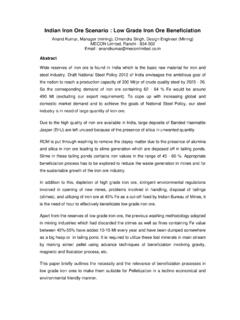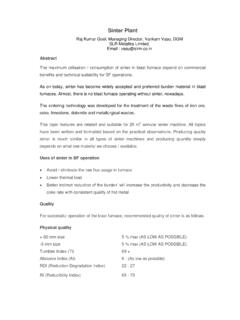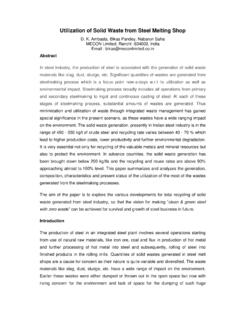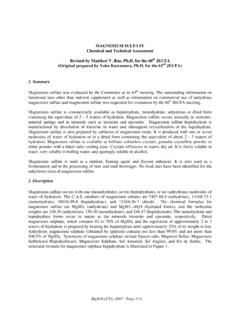Transcription of Effect of Hydration in Magnesia Based Refractories for ...
1 Page 1 of 8 Effect of Hydration in Magnesia Based Refractories for Lime Kiln Industry Debarati Nandy*, Soumen Banerjee**, Bhattacharjee** * Sr. Design Engineer ( Refractories ), MECON Limited, Ranchi ** Sr. Manager ( Refractories ), MECON Limited, Ranchi ** Dy. General Manager (Iron Making) & In)charge ( Refractories ), MECON limited, Ranchi Abstract India is at the threshold of rapid growth in steel sector and all efforts are being made for achieving 300 MTPA of production by the year 2025. Since, lime is an integral part of steel making process, increase in steel production requires enhancement of production capacity of lime by installing additional/ new lime kilns.
2 While executing the recent expansion programme of various steel plants, it is observed that in most of the lime plants, brick lining collapsed during commissioning or prior to commissioning due to Hydration of magnesite bricks. Hydration of Magnesia (magnesium oxide or periclase, MgO) in refractory material generally occurs when the Magnesia comes into contact with humid air, water, or steam. Presence of brucite phase in the sample indicates Hydration and also there is a volume expansion up to 115%, due to density change. Extensive Hydration leads to crack formation and subsequently disintegration of the whole brick, resulting in total damage of refractory lining inside the kiln.
3 There are quantitative and qualitative methods to assess the degree of Hydration of Magnesia Based Refractories . This paper focuses on the study of Hydration behavior for Magnesia Based refractory bricks in correlation with its internal properties along with external properties like manufacturing, storage, transportation and application criteria for such type of Refractories are also illustrated here in view of practical aspect. 01. Introduction and fundamentals: Magnesia Based Refractories are widely used due to their high refractoriness, corrosion resistance and basic characteristic.
4 Magnesia Refractories are installed in refractory linings for various furnaces and kilns due to their superior properties. Magnesia bricks when compared to other type of Refractories , there exists a great concern regarding their vulnerability during exposure with water vapour. Hydration of Magnesia (magnesium oxide or periclase Magnesia ) in refractory material occurs when the material comes into contact with humid air, water or steam. This exposure can occur during storage, installation and drying. Magnesia in presence of water produces hydroxides. The Hydration of Magnesia to magnesium hydroxide [brucite, Mg (OH) 2] results in an increase in volume due to change in density.
5 The extensive Hydration leads to crack formation in the brick and can subsequently lead to disintegration of the whole brick. The disintegration occurs as the magnesium hydroxide (brucite) consists of powder which additionally has a bigger volume compared to the original Magnesia . Generally, Magnesia used in lime kiln refractory is either of dead burnt or fused type, which is produced from natural magnesite (MgCO3) or extracted from sea water. The physical and chemical properties of Magnesia Based Refractories are more complicated than those of pure Magnesia due to different level of impurities.
6 Accordingly Hydration reaction is also affected. Hydration reaction may take considerable time also. Page 2 of 8 02. Theoretical study & experimental results: The Hydration of MgO Refractories in lime kiln application was extensively studied. This study presents the experimental results on commercially available Magnesia bricks used in lime kiln while tested for Hydration resistance at various temperatures, during storage and even during service. The speed of Hydration depends on the contents of Magnesia in the brick, its structure and to a great extent on the temperature.
7 By nature MgO tend to react with humidity, even from air and most effective between 400C & 1200C in the following way. MgO + H2O = Mg (OH) 2 Under water, the Hydration is not fast but as soon as the water penetrates into it by evaporated form Hydration becomes faster. Magnesia bricks are therefore particularly endangered in humid hot climate and during heating up in the kiln in case wet bricks have been installed. The Hydration of Magnesia at room temperature with water vapor proceeds in four steps: I. Formation of a layer of chemically and physically absorbed water. II. Diffusion of Mg2+ and OH) ions in the layer of physically absorbed water.
8 III. Nucleation of brucite. IV. Crystal growth of Mg (OH)2 The Hydration reaction of magnesium oxide with liquid water or water vapor is a heterogeneous reaction and very dependent on the characteristics and physical properties of Magnesia , such as reactivity and surface area. These properties are strongly influenced by the preparation of Magnesia , such as the chemical form from which MgO is prepared ( Mg(OH)2, MgCO3, etc.), the calcinations temperature along with the holding time and the preparation atmosphere (vacuum, air, etc.). Both the temperature and the vapor pressures affect the Hydration rates for vapor phase Hydration .
9 Since Hydration starts from the surface, the specific surface area of Magnesia is particularly important for the Hydration process. Fine Magnesia particles ( with large specific surface area) have high Hydration rates. The surface properties of Magnesia , such as specific surface area and reactivity are determined by the temperature of the calcinations process and starting materials. The surface area reaches a maximum and then decrease with increasing the calcinations temperature. For example, the surface area of Magnesia produced by dehydrating Mg(OH)2 changes from about 320 m2/g at 350 oC to 70m2/g at 700 oC.
10 However, the surface area of Magnesia obtained by decomposition of magnesite (MgCO3) increase with the temperature up to 900 oC . The open porosity of Magnesia particles is another important property that influences Hydration . Solid MgO reacts slowly with water vapor. For porous Magnesia , the reaction proceeds between MgO and water condensed in the micro)pores and absorbed on the surfaces of Magnesia particles from water vapor. A sintered Magnesia clinker has a higher Hydration rate than a fused clinker, because typically the sintered Magnesia is higher in porosity (8)11%) than the fused Magnesia (porosity 3)5%).









